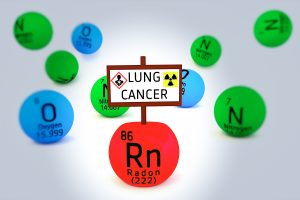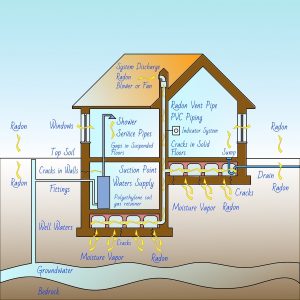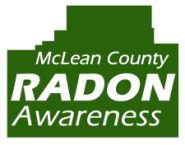 What is Radon?
What is Radon?
Radon (Rn) is a radioactive, colorless, odorless gas derived from the radioactive decay of uranium in the soil. Radon gas decays into airborne radioactive particles that, when inhaled, can remain trapped in your lungs. As these particles decay further, they release small bursts of radioactive energy that can damage lung tissue and lead to lung cancer over the course of your lifetime.
The United States Environmental Protection Agency (U.S. EPA) considers radon an environmental health concern because it is the second leading cause of lung cancer, surpassed only by smoking. Studies of lung cancer in underground miners prove that long-term exposure to elevated levels of radon presents a real physical health risk. The primary risk factors for developing radon-induced lung cancer include:
- The amount of radon in your home
- The amount of time you spend in your home
- Whether or not you smoke or have ever smoked
 Radon in Your Home
Radon in Your Home
Radon moves up through the soil to the air above and enters your home through cracks, gaps, and other holes in the foundation. Your home traps the radon inside, where it can accumulate.
Every homeowner should test his/her home for radon because any home (new and old, well-sealed and drafty, with or without a basement) may contain elevated levels of radon.
According to the U.S. Environmental Protection Agency (EPA), nearly one home in fifteen in the U.S. has elevated radon levels—that is, a radon concentration above the U.S. EPA action level of 4 picocuries per liter of air (pCi/L). These homes require mitigation to reduce or eliminate the health risks associated with radon.
Radon in Your Granite Countertops
Radon can also enter your home through granite countertops. Though the probability of dangerous radon levels from granite countertops is low you should consider having your granite countertops tested.
Radon in Your Water
Radon can also enter a home through the water supply, but in most cases this presents a much smaller health risk than radon in the air. Though not present in most municipal water supplies, radon may exist in well water. Water vapor from the shower and other household uses can release radon particles into the air. Also, research suggests that ingesting water with high radon levels may pose some health risks.
If your water comes from a well and if you’ve tested and detected elevated radon levels in the air, contact a laboratory that is certified to measure radiation in water to test your water supply. If your water comes from a municipal water supply and you are concerned that radon may be entering your home through the water, contact your public water supplier.
If you have questions about radon in your drinking water in Illinois, you should call the IEMA Radon Hotline at 1-800-325-1245, or the EPA Safe Drinking Water Hotline at 1-800-426-4791.




